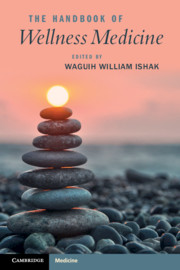Book contents
- The Handbook of Wellness Medicine
- The Handbook of Wellness Medicine
- Copyright page
- Dedication
- Contents
- Contributors
- Part I Approach to Wellness
- Part II From Illness to Wellness by Organ Systems/Disorders
- Chapter 6 The Concept of Wellness in Psychiatric and Substance-Use Disorders
- Chapter 7 Neurological and Neurosurgical Disorders and Wellness
- Chapter 8 Cardiovascular and Pulmonary Wellness
- Chapter 9 Gastrointestinal System and Wellness
- Chapter 10 Wellness and the Genito-Urinary System
- Chapter 11 Reproductive System
- Chapter 12 Allergic, Infectious, and Immunological Processes
- Chapter 13 Wellness in Endocrine and Metabolic Disorders
- Part III Special Populations and Special Topics
- Part IV Wellness Interventions
- Part V Wellness through Optimization of Work, Love, and Play
- Book part
- Index
- References
Chapter 12 - Allergic, Infectious, and Immunological Processes
from Part II - From Illness to Wellness by Organ Systems/Disorders
Published online by Cambridge University Press: 18 September 2020
- The Handbook of Wellness Medicine
- The Handbook of Wellness Medicine
- Copyright page
- Dedication
- Contents
- Contributors
- Part I Approach to Wellness
- Part II From Illness to Wellness by Organ Systems/Disorders
- Chapter 6 The Concept of Wellness in Psychiatric and Substance-Use Disorders
- Chapter 7 Neurological and Neurosurgical Disorders and Wellness
- Chapter 8 Cardiovascular and Pulmonary Wellness
- Chapter 9 Gastrointestinal System and Wellness
- Chapter 10 Wellness and the Genito-Urinary System
- Chapter 11 Reproductive System
- Chapter 12 Allergic, Infectious, and Immunological Processes
- Chapter 13 Wellness in Endocrine and Metabolic Disorders
- Part III Special Populations and Special Topics
- Part IV Wellness Interventions
- Part V Wellness through Optimization of Work, Love, and Play
- Book part
- Index
- References
Summary
The construct of “wellness” as it pertains to this chapter derives from an understanding of the interactions among psychosocial factors and behavioral changes, neuroendocrine responses, immune system changes, and inflammatory responses, and the impact of these relationships on physical health status. Mental and physical health and wellness are direct outcomes of the life stressor–social support–coping strategies (SSC) model, which addresses “mind–body medicine” (behavioral medicine) and the development of interventions centered on emotional, mental, physical, and spiritual well-being [1, 2]. Understanding the dynamic between these different facets of health will involve the psychosocial context of the person. This context predicts outcomes of disease prevention and positive wellness.
- Type
- Chapter
- Information
- The Handbook of Wellness Medicine , pp. 135 - 159Publisher: Cambridge University PressPrint publication year: 2020
References
- 1
- Cited by



